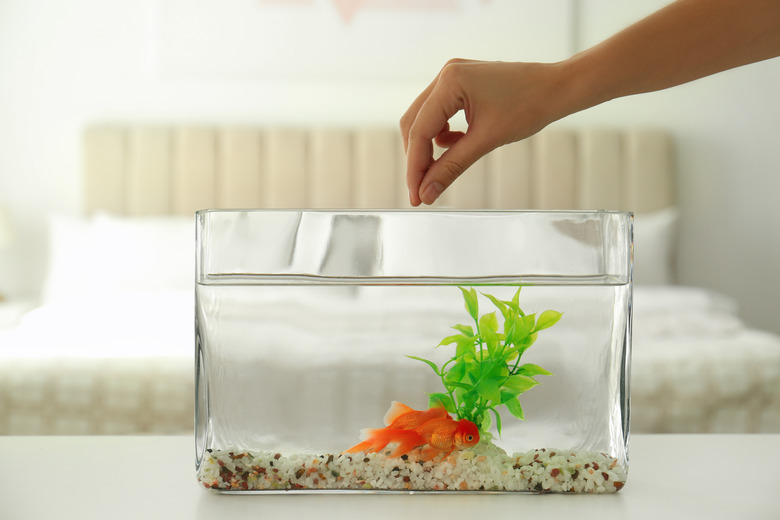How To Assemble A Top Fin Aquarium
Top Fin aquariums come in sizes ranging from 1 gallon to 150 gallons in a variety of shapes, ensuring you'll have the right size for the fish you desire and the space at hand. Setup is easy, especially for a Top Fin 3-gallon tank, but it takes time and attention to detail to ensure the chemistry of the water is correct before adding your aquatic pets.
Select the right type
Select the right type
Before buying a Top Fin aquarium, you'll need to pay attention to several details. Plan to buy the largest aquarium that fits your budget and the space available in order to give fish room to grow. Most fish you buy in the fish store will grow rapidly, and you'll find yourself having to buy a larger tank as they grow. Check out what size your fish will become and make sure to select a size that will accommodate the number of fish you want to have at their full growth.
Top Fin aquarium starter kits come in sizes up to 150 gallons. That would be an adequate size to keep larger cichlids, goldfish, or other fish that grow up to 24 inches. If you're looking for a peaceful aquarium that sits on your desk at work, a nano aquarium can be right for fish who stay tiny, a goldfish or two, or a betta fish.
Buy appropriate accessories
Buy appropriate accessories
Instructions for a Top Fin 10-gallon bubble wall glass aquarium, for example, recommend adding a heater to keep your fish at a constant temperature. Hardy, cold-water fish, such as goldfish, don't necessarily need one if you keep the tank in an area where the temperature remains constant.
Gravel is another must. Gravel helps healthy bacteria grow in your aquarium that can help devour ammonia and harmful nitrates that can make your fish sick. The Top Fin aquarium kit contains the basic framework, such as the hood, lights, filter, and tank. You'll need to buy your own decorations, such as plants and caves for hiding.
You'll also need a water conditioner, bacteria starter, and a water test kit. Maintaining proper water chemistry is crucial to your fishes' health and longevity.
Preparing for fish
Preparing for fish
Set up and cycle your aquarium before adding any fish. Start by thoroughly rinsing the inside of the tank to remove any dust or residue that could release toxins once you add water. Rinse all accessories and decorations you plan to add as well, including gravel or other substrates.
Situate the tank on the aquarium stand or other area where it will be resting. Clean the surface thoroughly to make sure there are no grains of sand, gravel, or other debris underneath the tank that could scratch it or put pressure on the glass bottom. Once it is in place, add the washed substrate to the tank and fill it slowly with water a little at a time to avoid disturbing any sediment. You can then add the filter and position the washed decorations before filling the aquarium to a half inch from the top with room-temperature water.
Position the heater and light hood and plug them in along with the filter. Add water conditioner and bacteria starter and let your tank run for up to 48 hours before adding live plants or fish.
Add the fish
Add the fish
Once your tank has cycled, you can add fish to the tank. Your fish will come home from the store in a plastic bag or another plastic container. Let it float in your tank for 20 minutes so the temperature in the container adjusts to the temperature in your tank.
Open the bag and add 1/2 cup of aquarium water to the bag. After five minutes, add another 1/2 cup. This helps your fish acclimate to the water conditions in your tank. After waiting another five minutes, gently release the fish from the plastic bag into the aquarium.
Monitor water conditions
Monitor water conditions
If your aquarium becomes overloaded with waste products, ammonia and nitrates can make your fish sick or can even kill them. Use a water-testing kit to check pH, ammonia levels, and nitrates at least once a week.
The ideal pH depends on what type of fish you have. For a community tank, a pH of 7.0 will keep most of the inhabitants in good health. Goldfish and livebearers prefer a slightly more alkaline environment of 7.2 to 7.5, and cichlids thrive at acidic conditions of 6.5 to 6.8. You can use pH adjuster drops to bring the water to the preferred level, but if the pH is off, you'll want to make sure that ammonia and nitrates aren't causing the problem.
Ammonia and nitrites are products of fish waste, such as respiration, excretion, leftover food, and decaying plant matter. Bacteria convert these toxic substances to nitrates that aren't as toxic to fish. However, too many nitrates can stimulate algae blooms or other water conditions, leading to fish disease. It's important to test your water regularly, clean your tank weekly, and perform partial water changes as needed to keep your tank thriving.
References
- PetSmart: Top Fin Awaken Half Moon Starter Kit
- PetSmart: Top Fin Enchant Aquarium – 3.5 gallon
- PetSmart: Top Fin Essentials Aquarium Starter Kit
- Pet Helpful: 10 Best Large Fish for a Freshwater Aquarium
- Epic Aquarium: Setting Up a Freshwater Aquarium
- Aqueon: Aquarium Setup
- API: Freshwater Test Kit Instruction Manual
